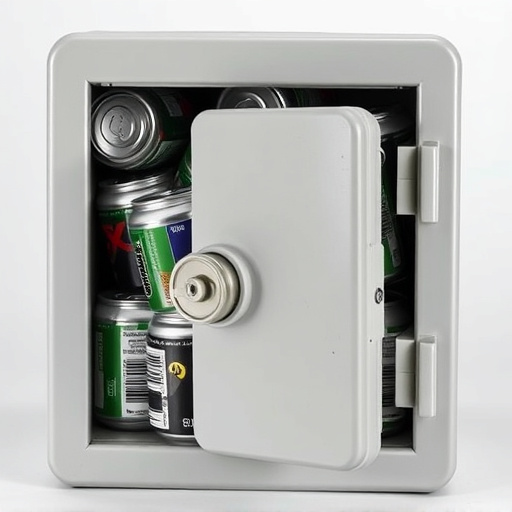"Unveiling Creative Disguise Techniques introduces innovative Fool Proof Diversion Safe Designs where everyday items like books and pen holders hide secret compartments, offering enhanced security and aesthetic appeal. These designs combine craftsmanship, material selection (leather, synthetic textures), and minimalist aesthetics with mechanisms like hinge doors or magnetic closures. While beneficial for personal and law enforcement use, they raise privacy concerns prompting debate on regulation, consumer awareness, and responsible design to balance security and rights."
Uncover the art of secrecy with hidden compartments disguised as everyday items. From ingeniously designed safes that look like common household objects to masterfully crafted hides, this exploration delves into creative disguise techniques that offer both security and stealth. We’ll analyze the engineering behind these foolproof diversion safe designs, examining materials, mechanisms, and minimalist aesthetics. Additionally, we’ll navigate ethical considerations and real-world applications, balancing privacy concerns with enhanced security.
- Unveiling Creative Disguise Techniques: From Everyday Objects to Masterful Hides
- Engineering the Perfect Secret Compartment: Materials, Mechanisms, and Minimalism
- Ethical Considerations and Real-World Applications: Balancing Security and Privacy Concerns
Unveiling Creative Disguise Techniques: From Everyday Objects to Masterful Hides
Unveiling Creative Disguise Techniques reveals a fascinating world where everyday objects transform into masterfully hidden compartments, offering fool-proof diversion safe designs. From innocuous-looking books to seemingly ordinary pen holders, artisans and inventors have mastered the art of concealing secret spaces within common items. This clever approach ensures discretion and security, making it nearly impossible for untrained eyes to detect the hidden mechanisms beneath.
Each disguised compartment is a testament to intricate craftsmanship, leveraging subtle design elements like concealed hinges, cleverly placed false bottoms, or specialized materials that allow for seamless integration of a secure storage area. These techniques not only provide an added layer of safety but also add aesthetic appeal, making them desirable both functionally and aesthetically in various settings, from homes to offices.
Engineering the Perfect Secret Compartment: Materials, Mechanisms, and Minimalism
Creating a secret compartment that’s both functional and undetectable requires meticulous craftsmanship, innovative design, and the selection of just the right materials. The most fool proof diversion safe designs seamlessly integrate hidden storage into everyday objects, rendering them virtually invisible to the untrained eye. For example, a book with a hollowed-out spine or a faux rock with a secret cavity can offer ample space for valuable items while appearing completely innocuous.
Minimalist aesthetics play a crucial role in achieving success here. Simple, clean lines and unassuming forms allow these compartments to blend seamlessly into their surroundings. Mechanisms like hinge doors, sliding panels, or magnetic closures add an element of sophistication while ensuring easy access and secure closure. Choosing materials that complement the intended environment is paramount; from aged leather for vintage-themed hides to realistic synthetic textures that mimic natural stone or wood grain, options abound to suit any taste and setting.
Ethical Considerations and Real-World Applications: Balancing Security and Privacy Concerns
In the realm of secret compartments disguised as common items, ethical considerations and real-world applications demand a delicate balance between enhancing security and respecting privacy concerns. As foolproof diversion safe designs become increasingly sophisticated, they raise questions about potential misuse and the consequences for individuals and society at large. While these innovative solutions offer robust protection for valuable assets or sensitive information, it’s crucial to consider the implications of their widespread adoption.
Privacy advocates argue that the proliferation of hidden storage spaces could lead to an erosion of trust and increased surveillance. On the other hand, proponents emphasize the benefits in fields like law enforcement and personal security, where discreet storage can facilitate operations and protect individuals from harm. Navigating this labyrinthine landscape requires careful consideration of regulatory frameworks, consumer education, and responsible design practices to ensure that the pursuit of enhanced security does not inadvertently compromise fundamental rights and freedoms.
In the realm of secret compartments, mastering disguise techniques offers a fascinating blend of creativity and security. From everyday objects to masterful hides, these designs provide fool-proof diversion safe options that balance functionality with stealth. As we’ve explored, engineering minimal yet innovative mechanisms is key to creating hidden spaces that are both discreet and accessible. While ethical considerations remain vital, the real-world applications of such technology promise enhanced privacy and security for individuals seeking discretion. With continued innovation in material science and design, the future of foolproof diversion safe designs looks set to revolutionize personal security measures.
